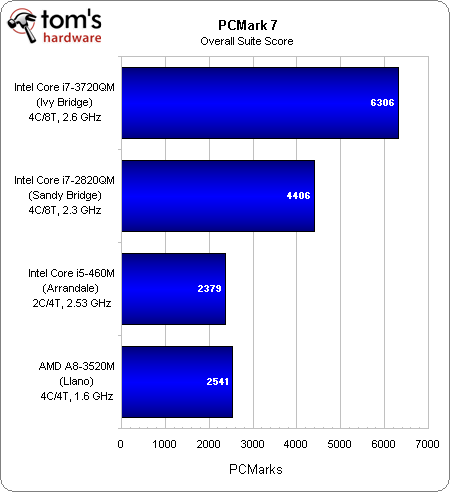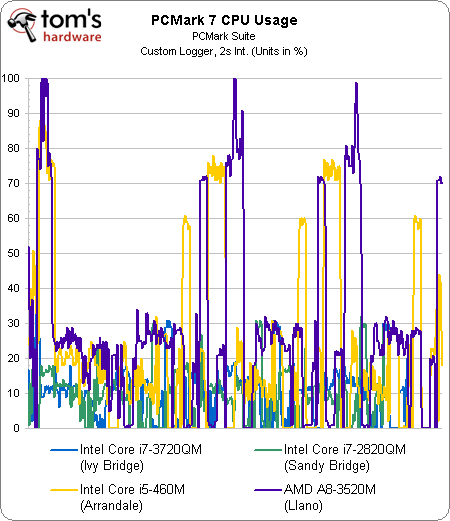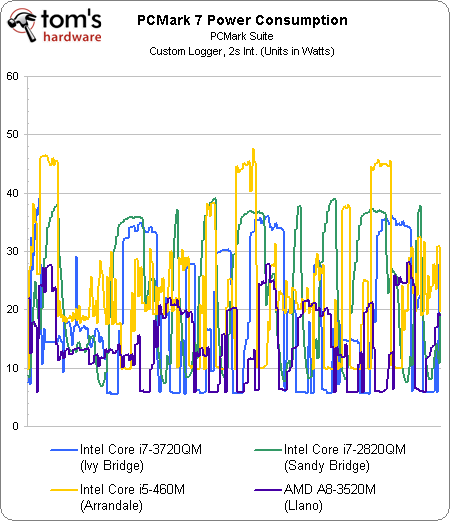Core i7-3720QM: Ivy Bridge Makes Its Mark On Mobility
Benchmark Results: PCMark 7
In PCMark 7, the Ivy Bridge-based Core i7-3720QM at 2.6 GHz (with a 3.6 GHz maximum Turbo Boost frequency) outpaces the Sandy Bridge-based -2820QM by ~40%, and it surpasses the Arrandale-based Core i5 by ~275%. The -3720QM's score is even more impressive compared to AMD's A8-3520M, as the Llano-based APU barely manages to outperform Intel's Core i5-460M.
Drilling down, the testing reveals some interesting finds (which actually start to call PCMark's weighting into question). Even though the Core i7-3720QM clearly leads the pack, its performance advantage is evident in only a few scenarios.
| PCMark 7 Results | i7-3720QM | i7-2820QM | i5-460M | A8-3520M |
|---|---|---|---|---|
| Video Playback | 23.12 FPS | 23.16 FPS | 23.14 FPS | 22.99 FPS |
| Video Transcoding | 169 531.73 KB/s | 17 416.99 KB/s | 1828.96 KB/s | 2460.25 KB/s |
| Storage: Gaming | 15.22 MB/s | 14.87 MB/s | 12.13 MB/s | 14.11 MB/s |
| Graphics DX9 | 22.99 FPS | 17.47 FPS | 13.29 FPS | 4.19 FPS |
| Image Manipulation | 11.55 Mpix/s | 9.3 Mpix/s | 4.00 Mpix/s | 7.41 Mpix/s |
| Storage: Importing Pictures | 26.37 MB/s | 26.58 MB/s | 25.42 MB/s | 24.12 MB/s |
| Web Browsing | 15.17 pages/s | 14.24 pages/s | 6.7 pages/s | 9.34 pages/s |
| Data Decrypting | 145.54 MB/s | 101.31 MB/s | 39.10 MB/s | 49.95 MB/s |
| Storage: Windows Defender | 5.37 MB/s | 5.25 MB/s | 4.22 MB/s | 4.97 MB/s |
The Core i7-3720QM particularly shines in tests involving:
- Video Transcoding
- DX9 Graphics
- Web Browsing
Because transcoding is so demanding, Intel built fixed-function hardware into its Sandy and Ivy Bridge-based architectures to address it, and the effect of that hardware is made apparent in PCMark 7, grossly inflating the synthetic's score compared to what you'd get from, say, an SSD or discrete graphics card.
With regard to 3D performance, the HD Graphics 4000 engine delivers ~30% higher results than HD Graphics 3000 in the DX 9 benchmark. Futuremark says that the Web browsing test has a 50/10/40% workload distribution between CPU, RAM, and GPU, making it an interesting measure of productivity.
Even though the AMD A8-3520M has four physical cores (compared to the Core i5-460M’s two cores), PCMark 7 works the Llano-based APU harder than the dual-core chip (indicated by overall CPU usage). And yet, our power consumption graph makes it clear that the APU still uses less power.
The Core i7-3720QM and Core i7-2820QM don't exhibit the same spikes in utilization, likely as a result of QuickSync offloading the demanding transcode workload from the general-purpose compute cores. Nevertheless, their higher performance incurs a greater power consumption penalty, and they both use more than AMD's A8-3520M.
Get Tom's Hardware's best news and in-depth reviews, straight to your inbox.
Current page: Benchmark Results: PCMark 7
Prev Page Understanding Ivy Bridge's Real Target Next Page Benchmark Results: Adobe Photoshop CS 5-
fstrthnu Would there be a noticeable performance gap between the i7-3720QM and the i7-3612/5QM? I'm trying to decide whether the extra 300 Mhz is worth ~$150 more (which I'm guessing not really)Reply -
s3anister fstrthnuWould there be a noticeable performance gap between the i7-3720QM and the i7-3612/5QM? I'm trying to decide whether the extra 300 Mhz is worth ~$150 more (which I'm guessing not really)Reply
There would be a performance difference in applications that could use the extra MHz (Video games, encoding/decoding) and performance would scale accordingly. Otherwise no you'd likely never notice. -
dragonsqrrl Wow, it looks like Ivy Bridge is a very compelling option in the mobile market. I had no idea the mobile versions of Llano were so performance constrained by their TDP. The graphics performance results are especially interesting. Just turned my whole world view upside down.Reply
Great job. Another excellent review Andrew. -
fstrthnu It looks like the Geforce GT650M in the notebook I'm looking at would bottleneck faster than the processor would, so I guess I'll save $$ thenReply -
DjEaZy ... why there waz no screenshots of picture quality differences in games between intel's HD4000 and AMD's HD6620?Reply -
blazorthon dragonsqrrlWow, it looks like Ivy Bridge is a very compelling option in the mobile market. I had no idea the mobile versions of Llano were so performance constrained by their TDP. The graphics performance results are especially interesting. Just turned my whole world view upside down.Great job. Another excellent review Andrew.Reply
To be fair, it was a low power APU being bench-marked against higher end, higher power, and newer chips. I would be surprised if it won much of anything, besides power usage, against the Sandy and Ivy i7s. A higher TDP mobile A8 might be able to beat HD 4000 if it had 1600MHz or maybe even 1866MHz memory, granted it still wouldn't win in CPU performance. -
ojas Interesting review. But i guess people are likely to point out differences in price (thus affecting performance/$), and RAM speeds, which apparently impact IGP performance.Reply
IIRC, the IGPs on the mobile chips can be OC'd, right?
The Core i7-3720QM particularly shines in tests involving:
Hmmm...wouldn't you agree that "data decryption" should be on this list too? The difference b/w each proc is significant...plus you've got hardware acceleration for AES256 on SB and IB...
Video Transcoding
DX9 Graphics
Web Browsing
I hope the mobile i3s get HD4000...still wondering why the i5s didn't get it... -
DavidC1 Andrew, love the review. But there's what seems to be a big error. You said on the power usage tests that AMD defaults to max battery life while Intel goes to balanced? Looking at World of Warcraft results, it looks like all the other results may be running max battery life mode for the AMD A8 chip.Reply
The i5-460M is faster than A8-3520M, just not that much faster. I have a feeling you need to run the application and gaming tests on max performance all over again. It doesn't matter for the Intel part as Balanced pretty much performs like max performance. -
DavidC1 Also, you need to do a battery life test. Power usage and battery life tests are hard to connect, because of advanced power management techniques and different usage models.Reply


